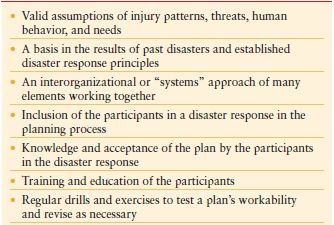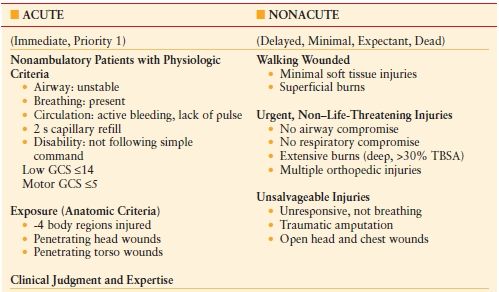CHAPTER 17

DISASTER PREPAREDNESS AND MASS CASUALTY MANAGEMENT
Police find car bomb in Times Square
A crude car bomb of propane, gasoline and fireworks was discovered in a smoking Nissan Pathfinder in the heart of Times Square on Saturday evening, prompting evacuation of thousands of tourists and theatergoers………. “We were very lucky” said Mayor Michael Bloomberg. “We avoided what could have been a very deadly event”New York Times May 1, 2010
Storms Cut through Midwest, killing 5
Hundreds of homes and businesses were damaged or destroyed Friday in Kansas, Kentucky, Illinois, Missouri and West Virginia prompting several state of emergency declarations.New York Times May 9, 2009
Imagine for a moment being on duty in a hospital adjacent to either scene above. The destruction of the second versus the absolute luck involved in avoiding the tragedy of the first is mind boggling. How would you, as an individual, your hospital and its staff, or your community at large have responded to either event? Who would be in charge? Where would injured patients go? How would they get there? How did they get here so fast? How would we, or could we, treat them? Where are the necessary supplies? What about the worried family members flocking to the hospital to find family members? Where do they go? How do I find out who goes with whom? What do we do with the ordinary patient traffic of the day in light of either of these events?
The easy answer is that “they” will take care of it. Unfortunately, the “they,” usually thought of as a governmental agency, is not able to respond fast enough in the first hours to substantially impact the situation. The “they” realistically is “us.” Disaster and mass casualty situations have distinct defining characteristics that need to be understood to appreciate the mindset change needed to deal with the problems.1 Command and control is paramount but its mechanisms are not obvious to the individuals who spend most of their professional time in hospitals engaged in routines of care. How we view patient care needs to fundamentally change in such situations. Finally, unless we are committed to understanding these differences and practicing the responses demanded, we will be doomed to fail. At that point, we will be tasked with answering why we weren’t better prepared only to realize that there is no good reason. The ultimate goal of such a response is to make ours a resilient community, that is, to build a community that can withstand the insult and return to normal structure and function with minimal deformation. To this end, the objective of this chapter is to begin to lay a foundation to support “us” as we develop a methodology to accomplish this goal.
DEFINITIONS
A disaster or mass casualty event in some ways depends on where you are at the time. A two-car, five-victim crash on the interstate may be routine to the urban level 1 trauma center but devastating to the much smaller critical access hospital in a rural county. The crux of the definition lies not in numbers or severity of injuries but in relation to the capability and resources of the responding community, be that EMS or hospital. Once the demands of the response outstrip the available resources, the situation warrants the label disaster or mass casualty. Frequently, the outstripped resources represent more than just local capabilities but expand to regional if not national capabilities. The occurrence of such events is thought sufficiently rare that two things occur. First, we believe we will never be called upon to deal with such catastrophe; thus, we have little need to be prepared. Second, the event is attributed to a random, fate-driven, unpredictable occurrence over which we have no control at any level. Unfortunately, the student of history soon discovers the fallacy underlying both of these assumptions. Recent history, well documented in the lay press, is replete with examples of both natural and man-made events that fulfill the definition of needs exceeding resources at several levels. Further study of this history will reveal patterns that are common to all such events. This knowledge can form the core around which response methodologies can be developed. Rather than try to develop unique solutions for every imaginable occurrence, we can build on the common themes present in the disaster situation and the needed response. A template can be developed, trained, critiqued, and refined until there is a cogent understanding and response methodology in place.
Disasters can be natural, such as hurricane, tornado, earthquake, or flooding. They can be man-made, intentional or unintentional, such as the bombing of a building, fire through carelessness or an industrial accident in a commercial district of a city or rural area. They can be finite such as a building collapse that is confined in a particular time and place or ongoing, such as an open forest wildfire that will spread through hundreds of acres over weeks or flooding subsequent to a hurricane, the effects of which persist months if not longer. Despite the seemingly endless possibilities, there are lessons to learn if we are attentive enough. Specific injury patterns are associated with different mechanisms. Common to all these disasters is environmental exposure, either as heat or hypothermia. Burns are common. Blast effects are common as explosions frequently accompany many of these events. Inhalation of substances dispersed into the air is very common. Exposure to chemicals or radiation is common. Very important and frequently overlooked is the psychological effects of the event on both the victim population and the responding caregivers.
The importance to us as surgeons is that we are looked to as an important cog in the wheel of first responders. The infrastructure our trauma systems are built on will become paramount in mounting this response. Our background in rapid situational analysis and decision making makes us well versed in the skills now needed to overcome the event at hand. Unfortunately, we have backed away from engaging this challenge. Unfortunately, or fortunately, we are a key component of the response system the public will look to in the face of such events. This response is not empiric though. It is very different from everyday practice, even in the busiest of trauma centers. It is not even accorded any part of routine medical training at any level.
Important to recognize here is that the disaster has a life cycle as does any other organism. Appreciation of the phases of this cycle is a key starting point as we begin to develop our response methodology. The initial phase of the response is characterized by utter chaos. Normalcy is gone, leadership is nonexistent, and hysteria and fear prevail. How long this phase lasts is difficult to determine. Urban areas with rapid response times of organized police, fire, and rescue units may do a better job of curtailing the chaos than more rural communities just by nature of time and distance. What is true though is that until trained staff can superimpose a command and control structure, the chaos will continue. While the chaos is unabated, the population remains at risk and the situation will continue to escalate (Table 17.1).
TABLE 17.1
PHASES OF A DISASTER RESPONSE
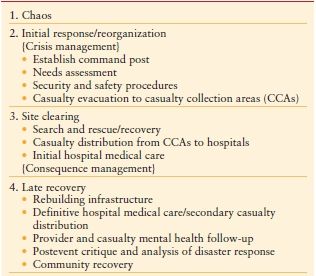
(From Stein M. Hirshberg A. Medical consequences of terrorism: the conventional weapons threat. Surg Clin North Am. 1999;1537–1552.)
The initial response and reorganization phase is characterized by the imposition of crisis management. This begins with the arrival of the first responders. A command structure is set up and a situational assessment made. A security methodology to minimize further injury is established. Search and rescue operations begin and patients are moved to appropriate locations. One caveat here is that good training, planning, and rehearsal will shorten the time required to set up this phase of the response. In the absence of such preparation, this may never get off the ground until far too late in the evolution of the disaster.
The initial response phase gives way to the site clearing phase. The transition can be thought of as the transition from crisis management to consequence management. Search and rescue may move to search and recovery as victims are rarely found alive beyond 48 hours after the event. Debris is cleared. Causalities are moved to hospitals for definitive care.
Finally, the event enters the phase of late recovery. Definitive medical care is rendered. Infrastructure is rebuilt. A rigorous critique of the situation and the response is carried out. The psychological health of the victims and responders is assessed and treatment plans developed. The community determines what it needs to return to normal.2 None of this happens a priori. How we begin to accomplish this follows next.
PLANNING
Military history can teach us much about planning. Dwight Eisenhower emphasized the planning process, not the plan per se, as the important component. George Patton espoused that plans need to be as simple and flexible as possible and made by those who will actually carry them out. All hospitals are required by the Joint Commission to have and rehearse a disaster plan on a regular basis. Thinking back to the last disaster plan discussion, much less drill, you may have participated in may give you some insight into the magnitude of the planning and preparation efforts of your institution. The disaster management cycle is illustrated in the accompanying diagram (Fig. 17.1). Ideally, we would like to begin by realizing what we need to prepare for, prepare for it, and then respond when tasked to do so. Historically, we frequently attempt to respond to the situation and make up a plan as we go. Hardly optimal. Plans are only as good as the assumptions they are based on. There are several elements deemed essential to a realistic plan (Table 17.2). There need to be valid assumptions about the threats faced; there needs to be some dependence on past performance critique; a systems approach that pulls together all components of the organization is important; everyone expected to participate in the execution of the plan needs to be part of the planning process; everyone needs to know and accept the plan; the expected participants need to be educated in the plan, both in a didactic and practical sense. Finally, the plan needs to be field tested, revised accordingly, and then retested.3,4
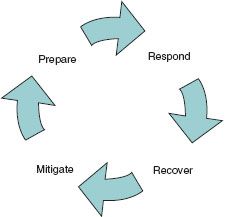
FIGURE 17.1. The disaster response cycle. We usually begin by responding to an incident rather than preparing to mitigate the consequences of the event. (From Disaster Management and Emergency Preparedness Course Manual. Chicago, IL: American College of Surgeons Committee on Trauma; 2010 with permission.)
TABLE 17.2
ESSENTIAL ELEMENTS OF DISASTER PLANNING
From Disaster Management and Emergency Preparedness Course Manual. Chicago, IL: American College of Surgeons Committee on Trauma; 2010.
The first essential component of planning is to carry out a Hazard Vulnerability Analysis (HVA). This is a realistic assessment of the likelihood of particular events in your community. Both natural and man-made events need to be considered. For instance, living along the southeast coast of the United States, hurricane and flooding would need to be considered high on that list. Several such templates are available on the Internet, but without a realistic assessment of one’s own location, the exercise is futile and the planning assumptions flawed.
Once the HVA has been completed, comes the difficult task of assessing readiness to deal with any of the events listed (Table 17.3). Who to bring to this discussion is an important decision. All the constituents of the community will own part of the response; thus, all need to be part of this analysis and discussion. This moves beyond the hospital quickly and encompasses governmental and private sector entities. The EMS community, police, fire, the media, religious organizations, local industry, and employers who will be affected all need to come to the table, be educated in and contribute to the planning process. History is also an important contributor to this discussion.
TABLE 17.3
KEY QUESTIONS TO BE ADDRESSED IN A HOSPITAL DISASTER PLAN
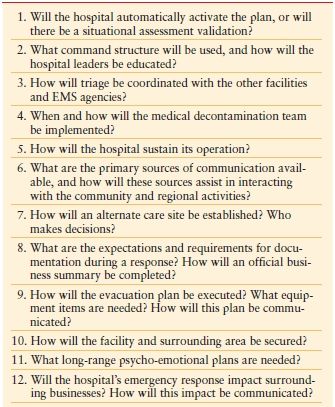
From Disaster Management and Emergency Preparedness Course Manual. Chicago, IL: American College of Surgeons Committee on Trauma; 2010.
To illustrate the point, consider for a moment a situation where water pressure and electricity to an entire region were lost, generators were inaccessible, supply chains destroyed, roads impassable, and the health care infrastructure gone. Hurricane Katrina in New Orleans certainly entailed all these problems. But Hurricane Hugo in South Carolina in 1989 did all the same. What lessons were transferable and learned from one to the other should be clear to the critical reader.
A few generalizations can be made as well as some methods of deluding ourselves noted. Klein and Weigelt5 comment on four areas of failure in disaster response. A communication system that completely collapses; no clear lines of authority; inadequate scene and hospital security and a disorganized health care system that tries to deliver care to all patients without appropriate triage. These become key considerations in the planning process. Delusion is a grand frame of mind and we fall into it regularly when we engage in disaster planning. We stage disaster drills with sufficient warning to all involved parties, we hold them during daylight hours and plan them not to inconvenience daily operations. We are not realistic in our assumptions about the consumption of supplies and minimize the need for resupply.
Finally, we will never be able to engage the disaster response adequately if we are not prepared in our own lives. The distraction of the safety of our own families is powerful yet can be tempered by attention to detail and arranging a methodology to have sufficient materials on hand at home. There are a variety of resources to guide us here, and the CDC and FEMA Web sites are excellent sources for this level of preparation.
INCIDENT COMMAND
Probably the most critical initial function of a disaster response is the establishment of an effective command and control methodology. This becomes obvious when one considers that large-scale events require multiple agencies to respond, each with their own command structure. Even within a small hospital, the issues with who is in charge or who is tasked with what responsibility in a given circumstance can be confusing. The necessity of establishing a functioning structure to control all the moving pieces is clear. The Incident Command Structure (ICS) used today grew out of the California wildfire experiences of the 1970s. The difficulty with coordination of activities among multiple responding agencies forced a better mechanism. After several iterations, the National Incident Management System was put forth by the Department of Homeland Security. The ICS was determined to be a best practice and is now the operational standard for all emergency response systems in the United States. While the ICS has its origins as a field operations tool, the inhospital equivalent parallels the field tool in descriptions and functionality. The Hospital Emergency Incident Command System is the same modular system with the same titles and responsibilities. It is intended to facilitate the coordinated response in the hospital and smooth the field-to-hospital transition.
The principles of the ICS are simple and straightforward. The goal is the rapid imposition of a command and controlsystem recognized by and agreed to by all response participants. Realizing that it can take up to 30 minutes to recoup every 5 minutes of chaos, such disaster situations induce a potent driver for such command and control systems. The ability to coordinate and escalate the response as needed is a key functionality of the ICS.
Structurally, the ICS allows expansion and contraction around several key positions (Algorithm. 17.1). The Incident Commander (IC) is the only position absolutely required in the construct. The concepts of unity of command and span of control are key factors that contribute to the functional success of this construct. Unity of command allows multiple agencies to coordinate activities under one overarching IC. The span of control is a recognition that everyone needs to report to only one clearly designated individual and that responders in leadership positions can only control a limited number of responders effectively, typically five to seven people. By keeping these lines of control well delineated and designated by job description rather than person, orderly progression and transfer of authority can occur.
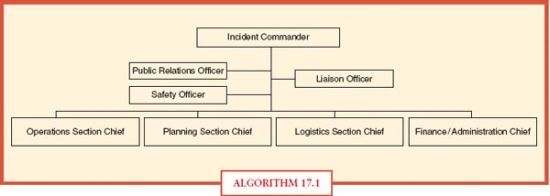
ALGORITHM 17.1 The incident command structure.(From Disaster Management and Emergency Preparedness Course Manual. Chicago, IL: American College of Surgeons Committee on Trauma; 2010 with permission.)
Surrounding the IC are several key positions, all with clearly delineated responsibilities. Utilization of the same vocabulary for job titles and positions helps to ensure clear understanding of expectations and responsibilities. The IC has ultimate responsibility for all aspects of the response. The IC can delegate as seen appropriate by utilizing the staff surrounding and directly reporting to the IC. For instance, the safety officer is responsible for a safety assessment of the situation so that first responders do not unnecessarily endanger themselves. The Public Information Officer is the communication link, via the media, to the public to keep them informed of the situation. The liaison officer is tasked with coordination with other agencies as appropriate. These positions constitute the command staff.
There are four primary functionalities required to mount an effective response. All four report directly to the IC. Likewise, all four can expand or contract the response system beneath them as needed. These four are termed the general staff. They are the planning section, the operations section, the logistics section, and the finance and administration section.
The planning section is tasked with being the brains of the operation. Situational awareness is critical and keeping the IC informed of developments the key function. Likewise, the planning chief will direct the other sections as to the plan to be executed. Keeping ahead of developments and seeing where a preexisting response plan works well or needs modification are essential components of this position. The recorded lessons learned will be important in the after-action critique.
The operations section is the doer responsible for all aspects of the response. Arguably, all the other positions exist to support operations. Anything that requires something being done, from field search and rescue to evacuation to care, is the responsibility of operations.
The logistics section is responsible for all the material and manpower assets associated with the response effort. If it is needed to meet the demands of the disaster, logistics is responsible to get it or have it.
The finance and administration section is the record keeper for all activities associated with the response effort. Response personnel need time records maintained. Cost of materials needs to be tracked. Claims compensation needs to be determined. The overall cost of the response needs to be evaluated, in both human and fiscal terms, and mechanisms looked for that may bring cost savings in the future.
The interdependence of the four functionalities is very clear. The IC tasks operations with accomplishing a specific goal. The planning section informs the IC of the situation and how it compares to the predesigned response plan. Logistics supplies the people and supplies to accomplish the goal, and finance tracks the costs associated. What is also very clear is that this does not occur spontaneously. The great fallacy of Incident Command is that by assigning titles I have accomplished this goal. Individuals do not deserve one title or another based on seniority or everyday position. Without the proper education and opportunity to rehearse these positions in realistic drills, the system will fail. In similar fashion, multiple individuals need to be prepared to fulfill any role. There should be no key individual whose absence stymies the operation. Likewise, there needs to be provision for the smooth transition of individuals in a given position should the disaster continue for a prolonged time.
DEFINITIVE MEDICAL CARE
Up to this point, nothing has been said about the actual care of any injured patient or patients. That is because without the imposed structure of a disaster response plan that can function,there is no definitive medical care. How to deliver care, where to do it, and who do we treat in what time frame are important questions that the response effort needs to answer. The mythology of disaster response needs to be appreciated as it will help guide our response.4
Popular mythology will contend that trained field personnel carry out initial field search and rescue operations. In reality, the survivors, or those less injured, perform this task. Similarly, the thought that the initial triage and treatment is done by trained providers is mythology. Survivors provide what they can and those injured who can move will self-transport to the closest health care facility. This uncovers another great myth, that patients are transported in an orderly fashion to appropriate hospitals. Victims of such events do not discriminate one type of hospital from another. All hospitals are equal and all are viewed as a safe haven for the injured. The hospital closest to the event will in all likelihood be flooded and overwhelmed by an influx of self-transported victims. By the very fact that these people were able to self-transport is indicative of their injury severity. The challenge for an individual hospital, and the larger response effort, is how to sort out those in need of immediate care from those with minimal or no injuries. Once identified, where do I send them and how do I do it? Can I provide the care I do everyday? Can I operate emergency services as I do every day when faced with such a circumstance?
TRIAGE
Modern American medical practice allows tremendous resource allocation toward any one patient regardless of the likelihood of survival. The resources that can be brought to bear usually so overwhelm the needs of the situation that the concept of rationing resources is virtually never considered. The modern trauma system is willing to accept tremendous overtriage in order to avoid undertriage at almost no consideration for the expenditure for that care. Quite the opposite when faced with a situation where, by definition, the resources needed to deal with a situation are outstripped by the demands of that situation. The triage process is arguably the most critical determinant of the success or failure of the response effort. Understanding the switch in mindset from an individual-based to a population-based health care ethic is crucial. The mechanics are straightforward but distinctly uncomfortable for the novice.
Triage is not a new or novel concept. The process of sorting based on severity of injury is used daily in emergency rooms around the nation. In reality, we do little real triage because of the overwhelming resources we command. The key first step to realize, when faced with a disaster or mass casualty event, is that we are no longer operating where the good of the individual is paramount. Rather, the distinctly public health perspective becomes operational and we now will make decisions based on the good of the greatest number or population as a whole. By definition, this means certain patients we would treat aggressively a few hours ago may now be relegated to delayed or expectant care. This is of course antithetical to our medical training, but without this mindset shift, the preventable mortality will increase markedly. Frykberg and associates6–8 have demonstrated the effect of poor triage on mortality. An analysis of a large number of international events shows that the overwhelming number of patients is minimally injured with soft tissue or relatively minor orthopedic injuries. The percentage of patients with life-threatening injuries that are amenable to treatment under the constraints of treatment imposed by the event is approximately 20%. The challenge then becomes finding those 20%, initiating care in the field, and moving them expeditiously to definitive care. The concept of critical mortality, the death rate among that 20%, has become a marker of the success or failure of the response.
Categorization of the injured for triage purposes allows for rapid initial sorting to identify who needs the most immediate care.9 While there are a number of methods available, there are common attributes that warrant discussion. The first pass at triage, done at or adjacent to the scene of the event, will sort victims into immediate or delayed categories. The immediate victim has a life-threatening injury or injuries and requires rapid treatment (Table 17.4). The qualifier here is that the treatment rendered needs to be simple to apply. Opening an airway, compressing hemorrhage, decompression of a tension pneumothorax, providing a rescue breath may fall into this category. Anything that ties up a rescuer beyond brief moments is not applicable. The delayed category victim is hemodynamically stable and can tolerate a period of no or minimal treatment without impacting mortality. Fractures, open or closed, soft tissue injuries, some penetrating wounds, and some burns will fall into this category.

Full access? Get Clinical Tree


